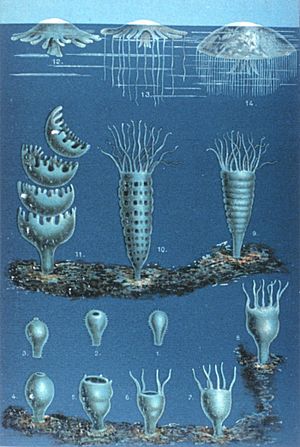Medusa (biology) facts for kids
A medusa is a type of sea animal that looks like an umbrella or a bell. It's one of the two main shapes that animals called cnidarians can have. The other shape is called a polyp, which usually stays attached to a surface. Medusae are often what people call jellyfish. They float freely in the ocean.
What is a Medusa?
Cnidarians are a group of animals that live in water. They include jellyfish, corals, and sea anemones. These animals can have two main body shapes. One is the medusa, which is like a bell or umbrella. The other is the polyp, which is shaped like a tube and usually sticks to a surface.
Medusae can be shaped like a deep bell or a flat, thin disk. The top, outer surface is called the exumbrella. The bottom, inner surface is called the subumbrella. The mouth is on the bottom surface. It might be partly covered by a thin edge called the velum.
Inside, medusae have a central stomach area called the gastrovascular cavity. From this, canals spread out like spokes on a wheel towards the edge of the bell. These canals help digest food and move nutrients around. The edge of the bell also has special parts for sensing things and tentacles.
Medusa Life Cycle

In some cnidarians, like the Hydrozoa class, medusae are the part of the life cycle that reproduces. They often switch between a medusa form and a polyp form. The polyp form attaches to a surface. The medusa form floats freely in the water. This means one species might look like a polyp at one stage and a medusa at another.
The medusa shape is most common in the Scyphozoa class. These are the large, colorful jellyfish you often see. It's also the main shape for Cubozoa, which are box jellyfish. Except for some freshwater hydrozoans, these are the only groups where medusae are found.
Stinging Tentacles
Medusae often have many tentacles. They use these tentacles to catch their food, like small fish. These tentacles are long and thin. They are covered in tiny, special stinging cells. These cells are called nematocysts.
When a medusa touches something, these stinging cells can inject a mild poison. This poison helps them catch and hold small fish. Sometimes, people swimming in the ocean might accidentally touch a medusa. The sting can cause pain and irritation. If someone gets a severe sting, they should get medical help.
Related pages
Images for kids
-
A purple-striped jellyfish at the Monterey Bay Aquarium
-
Fossil jellyfish, Rhizostomites lithographicus, one of the Scypho-medusae, from the Kimmeridgian (late Jurassic, 157 to 152 mya) of Solnhofen, Germany
-
Discharge mechanism of a nematocyst
-
The lion's mane jellyfish (Cyanea capillata) is one of the largest species.
-
The developmental stages of scyphozoan jellyfish's life cycle:1–3 Larva searches for site4–8 Polyp grows9–11 Polyp strobilates12–14 Medusa grows
-
Moon jellyfishes can live in northern hemisphere seas, such as the Baltic Sea.
-
Global harvest of jellyfish in thousands of tonnes as reported by the FAO
-
Rehydrated jellyfish strips with soy sauce and sesame oil
-
Pacific sea nettles (Chrysaora fuscescens) in an aquarium exhibit
-
Box jellyfish are small and venomous.














